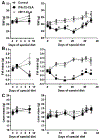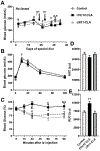Tissue-dependent effects of cis-9,trans-11- and trans-10,cis-12-CLA isomers on glucose and lipid metabolism in adult male mice
- PMID: 30856468
- PMCID: PMC6520122
- DOI: 10.1016/j.jnutbio.2019.01.020
Tissue-dependent effects of cis-9,trans-11- and trans-10,cis-12-CLA isomers on glucose and lipid metabolism in adult male mice
Abstract
Mixtures of the two major conjugated linoleic acid (CLA) isomers trans-10,cis-12-CLA and cis-9,trans-11-CLA are used as over the counter supplements for weight loss. Because of the reported adverse effects of CLA on insulin sensitivity in some mouse studies, we sought to compare the impact of dietary t10c12-CLA and c9t11-CLA on liver, adipose tissue, and systemic metabolism of adult lean mice. We fed 8 week-old C57Bl/6J male mice with low fat diets (10.5% Kcal from fat) containing 0.8% t10c12-CLA or c9t11-CLA for 9 or 38 days. Diets containing c9t11-CLA had minimal impact on the endpoints studied. However, 7 days after starting the t10c12-CLA diet, we observed a dramatic reduction in fat mass measured by NMR spectroscopy, which interestingly rebounded by 38 days. This rebound was apparently due to a massive accumulation of lipids in the liver, because adipose tissue depots were visually undetectable. Hepatic steatosis and the disappearance of adipose tissue after t10c12-CLA feeding was associated with elevated plasma insulin levels and insulin resistance, compared to mice fed a control diet or c9t11-CLA diet. Unexpectedly, despite being insulin resistant, mice fed t10c12-CLA had normal levels of blood glucose, without signs of impaired glucose clearance. Hepatic gene expression and fatty acid composition suggested enhanced hepatic de novo lipogenesis without an increase in expression of gluconeogenic genes. These data indicate that dietary t10c12-CLA may alter hepatic glucose and lipid metabolism indirectly, in response to the loss of adipose tissue in mice fed a low fat diet.
Keywords: Fatty liver; Insulin resistance; Lipodystrophy; Polyunsaturated fatty acids; de novo lipogenesis.
Copyright © 2019 Elsevier Inc. All rights reserved.
Conflict of interest statement
Figures








References
-
- Gholami Z, Khosravi-Darani K. An overview of conjugated linoleic acid: microbial production and application. Mini Rev Med Chem. 2014;14:734–46. - PubMed
-
- Koba K, Yanagita T. Health benefits of conjugated linoleic acid (CLA). Obes Res Clin Pract. 2014;8:e525–32. - PubMed
-
- De La Torre A, Gruffat D, Durand D, Micol D, Peyron A, Scislowski V, et al. Factors influencing proportion and composition of CLA in beef. Meat Sci. 2006;73:258–68. - PubMed
-
- Lee KN, Kritchevsky D, Pariza MW. Conjugated linoleic acid and atherosclerosis in rabbits. Atherosclerosis. 1994;108:19–25. - PubMed
-
- Nicolosi RJ, Rogers EJ, Kritchevsky D, Scimeca JA, Huth PJ. Dietary conjugated linoleic acid reduces plasma lipoproteins and early aortic atherosclerosis in hypercholesterolemic hamsters. Artery. 1997;22:266–77. - PubMed
Publication types
MeSH terms
Substances
Grants and funding
LinkOut - more resources
Full Text Sources

